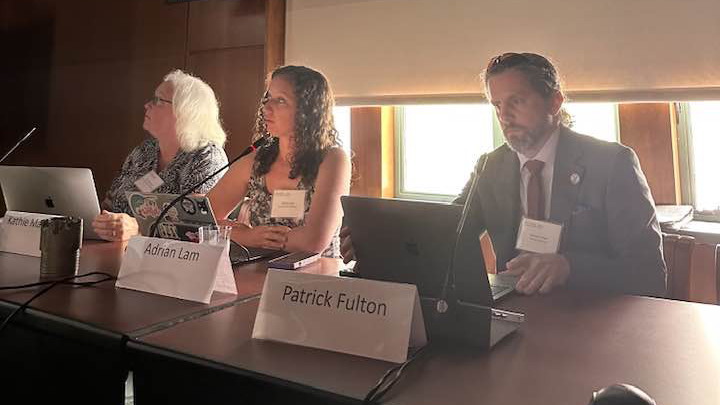The last sail: What happens to ocean-drilling research after 2028?
Assistant Professor Adriane Lam participates in panel on the future of ocean sciences

Ancient sediments offer a window into complex Earth processes that link both the atmosphere and the ocean, from currents to the health of biological marine communities, and ultimately the larger food chain.
That’s what makes the Joint Oceanographic Institutions for Deep Earth Sampling (JOIDES) Resolution so important for ocean scientists. Commissioned in 1985, the specialized ship can drill 2 kilometers into seafloor sediments, offering a glimpse into seas and climates of millennia past.
“Our knowledge of ancient climate change, of how the oceans respond to periods of increased warming and elevated greenhouse gases, comes from those records and from scientific ocean drilling,” explained Assistant Professor of Earth Sciences Adriane Lam. “That’s how we know and understand our future under increased global warming.”
After 2028, however, access to new sediment cores may come to a halt — for the next 20 years.
Lam was among the few early-career scientists asked to serve on a panel for the National Science Foundation’s 2025-2035 Decadal Survey for Ocean Sciences. Held by the National Academies for Sciences, Engineering and Medicine, the August meeting in Washington, D.C., asked experts in oceanic drilling to weigh in on high-priority research questions and the infrastructure required to answer those questions.
Training the next generation of ocean scientists in the field of ancient climate and biotic changes is a major objective of both Lam’s lab and that of Associate Professor of Earth Sciences Molly Patterson. The University recently became a member of the Chincoteague Bay Field Station, and two biogeochemistry groups within the First-year Research Initiative, four undergraduate students and three faculty members are actively working with scientific ocean drilling samples and data, Lam said.
“We are committed to ensuring our undergraduate to graduate students are involved with scientific ocean drilling through attending workshops and using deep-sea sediments in their research,” Lam said. “Our hope is that our students, and their students, will be the ones who continue the extraordinary legacy that is scientific ocean drilling.”
The NSF funds scientific ocean drilling, with cooperation from international partners in Europe, Japan, New Zealand and Australia. Its ocean-drilling ship, the JOIDES Resolution, will go out of service due to age in 2028. Because of a funding crunch, there are no immediate plans to replace it.
Lam will be on its last expedition to the Arctic next summer. She also has three doctoral students, all of whom are sailing or have applied to said next year.
“We’ve drilled hundreds of kilometers worth of core from that ship. We’ve learned so much about ancient climate change,” she said.
It takes between five and 10 years for a research proposal to make its way to shipboard science, Lam points out. If a new ship comes online 20 years out, that means she will potentially have to wait another 10 years after that to sail — when she’s around 65 years old.
That’s a long wait. And during that wait, the United States may no longer be capable of maintaining leadership within the scientific ocean drilling community, she said.
Without a drillship, scientists will likely focus their research on existing sediment cores, which are stored in three places: Bremen, Germany; Kochi, Japan; and College Station, Texas. During these “land-based expeditions,” they will take a fresh look at those legacy cores, using technology that may not have been available when they were initially drilled.
But even with the workarounds, much could potentially be missed if a drillship is no longer available. A recently emerging field of research concerns microbial communities that live within rocks on the seafloor, for example.
“It is the largest unexplored and unknown biological community on Earth today. Without drilling, we can’t drill into those rocks on the seafloor and even look at those communities,” she said.
